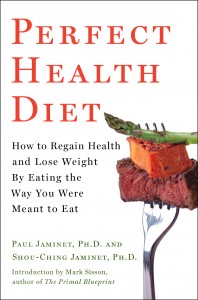T. Colin Campbell became famous for his book The China Study, which claims that a Chinese epidemiology study supports a vegetarian diet. Chris Masterjohn pointed out some time ago that Campbell’s conclusions had little basis in the study data. [1] Now, Denise Minger has delved into the raw data and shows clearly that Campbell has presented “a strongly misleading interpretation of the original China Study data.” [2] She concludes:
Campbell’s “China Study” book is a spectacular example of how you can cherry-pick data to create a trend that isn’t there. [3]
Campbell’s recommended diet is very different from the Perfect Health Diet. Although hardly carnivores, we at PerfectHealthDiet.com are not idolators of plant foods. Plants have much higher toxin levels than animal foods, and are more difficult to digest. Fiber is often adduced as a reason to eat plant foods, but fiber’s influence on gut bacteria is complex; not all plant fiber improves the composition of gut flora.
We recommend eating daily some safe starches (sweet potato and taro are our favorites; white rice is quick and easy), fruits and berries, seaweed, and assorted vegetables. We eat vegetables mostly to improve the flavor of our meals. What would a beef stir fry, chicken soup, omelette, or bibimbap be without vegetables?
But, though plant foods constitute 50-70% of the mass of food eaten on our diet, we recommend that carbs provide only 20% of calories.
So, now that Ms. Minger has summarized a lot of the data from the China Study, I thought it would be interesting to see whether the China Study data is supportive of the Perfect Health Diet. The China Study data, as summarized by Ms. Minger, is relevant to four of our claims.
1. Animal Proteins Are Preferable To Plant Proteins
The Perfect Health Diet deprecates plant proteins (which are often toxic) and recommends that protein be obtained from meat, fish, and eggs. However, we also recommend lower levels of protein consumption than other Paleo diets. We personally obtain about 10% of calories from protein.
So, did the China Study prefer plant or animal sources of protein? And what is its result for total protein intake?
Ms. Minger reports how protein intake is associated with cancer deaths:
[W]hen we look solely at the variable “death from all cancers,” the association with plant protein is +12. With animal protein, it’s only +3. [2]
The positive numbers mean that more protein is associated with more cancer deaths, suggesting that Chinese should eat less protein. Since the plant protein association is higher than the animal protein, it’s better to eat animal protein than plant protein. Just as we would expect!
What about heart disease?
Correlation between animal protein and myocardial infarction and coronary heart disease: +1
Correlation between fish protein and myocardial infarction and coronary heart disease: -11
Correlation between plant protein and myocardial infarction and coronary heart disease (from the China Study’s “diet survey”): +25
Correlation between plant protein and myocardial infarction and coronary heart disease (from the China Study’s “food composite analysis”): +21
Looking at myocardial infarction and coronary heart disease, fish protein was apparently protective (perhaps because it comes with omega-3 fats), animal protein was neutral (as we would expect from healthy protein, which is fairly innocuous health-wise), and plant protein was harmful (as we would expect from toxins).
2. Dairy Fats Good, Dairy Proteins Problematic
The Perfect Health Diet strongly approves of dairy fats (such as butter and heavy cream – clarified butter or ghee for those with dairy sensitivity) and approves of fermented dairy products (yogurt, cheese), but recommends avoiding most dairy protein – especially products containing pasteurized cow casein that has not been pre-digested by bacteria.
In the China Study, dairy proteins seem to have a strong relation to high blood pressure. Ms. Minger notes the following correlations with hypertension:
Milk and dairy products intake: +30
Egg intake: -28
Meat intake: -4
Fish intake: -14
Meat, fish, and eggs are all healthy. Milk and dairy products – higher blood pressure. Presumably this is because of the casein.
Cow casein, especially the pasteurized form which is difficult to digest, has various well-documented problems. Ms. Minger cites several studies showing that cow casein increases cancer growth, while milk whey and other protein sources are benign. [2]
3. Grains Are Bad; But Rice Is OK
The Perfect Health Diet strongly recommends eliminating all grains except rice. Wheat, which has an exceptionally high toxin load, is strongly deprecated. Rice, on the other hand, is accounted along with taro, sweet potatoes, and other underground starch storage organs among our “safe starches.”
Ms. Minger notes the extraordinary correlations of wheat consumption with disease rates:
Why does Campbell indict animal foods in cardiovascular disease (correlation of +1 for animal protein and -11 for fish protein), yet fail to mention that wheat flour has a correlation of +67 with heart attacks and coronary heart disease, and plant protein correlates at +25 with these conditions?
Speaking of wheat, why doesn’t Campbell also note the astronomical correlations wheat flour has with various diseases: +46 with cervix cancer, +54 with hypertensive heart disease, +47 with stroke, +41 with diseases of the blood and blood-forming organs, and the aforementioned +67 with myocardial infarction and coronary heart disease? (None of these correlations appear to be tangled with any risk-heightening variables, either.) [2]
Wheat was, indeed, by far the most toxic food found in The China Study. It consistently produced the highest correlations with disease. Ms. Minger concludes:
[W]heat may be one of the most toxic things you could ever put in your mouth. [3]
Note that almost everyone in China eats substantial amounts of either rise or wheat; the people who eat little wheat eat a lot of rice. Wheat has a high correlation with disease only because rice is anti-correlated with disease. If rice were not safe, wheat would not appear so dangerous.
In fact, the correlation coefficient of rice with heart disease deaths is -58%, almost the opposite of the +67% for wheat. Other grains had a correlation coefficient of +39%. [4] So: rice good, other grains bad, wheat worst of all.
4. Calories Should Come Predominantly From Fat
The Perfect Health Diet recommends obtaining most calories from fat: the ideal macronutrient ratio is around 20% carbs, 10% protein, and 70% fat by calories. These fat calories should consist of saturated and monounsaturated fats; polyunsaturated fats should be less than 5% of calories.
No region in China eats at these macronutrient ratios, but one comes substantially closer than others: the county of Tuoli. [5] Located in the far northwest of China, Tuoli is occupied by a herding people who traditionally eat a great deal of dairy and meat but very few vegetables.
While the average macronutrient intake of all counties in the China Study was 74% carbs, 10% protein, 16% fat, the macronutrient intake in Tuoli was 35% carbs, 19% protein, and 46% fat.
Helping the comparison with the Perfect Health Diet, the Tuoli obtain their fats predominantly from dairy and meat; these contain few polyunsaturated fats. Plant oils, legumes, nuts, eggs, and fish are all non-existent in their diet; so we can be sure they aren’t eating soybean oil, canola oil, or corn oil.
So how do the people of Tuoli stack up in health compared to the rest of China? Pretty well.
Death from all causes for people under the age of 65 was lower in Tuoli county than in 11 of the 13 counties that ate the least animal protein.
This excellent result was achieved even though the people of Tuoli are among the highest consumers of wheat in China: they average 0.82 pounds per day of wheat flour. Without their high consumption of this most toxic of foods, Tuoli county might have the best health in China. Add another point in favor of fat-rich diets.
But What About Seaweed?
In reading Ms. Minger’s discussion, I was able to find only a few correlations that went the wrong way. The only significant one was the correlation of sea vegetables with colorectal cancer (+76%). We highly recommend seaweed consumption, in part for its high content of iodine and other micronutrients.
However, as Ms. Minger notes, the association of seaweed with colorectal cancer is the result of a confounding factor. The areas of China that eat a lot of seaweed have very high rates of schistosomiasis infection, which is an extremely strong promoter of colorectal cancer.
Conclusion
At least in the data provided by Ms. Minger, there appears to be no data from the China Study that contradicts a recommendation of the Perfect Health Diet, and plenty of data that support our recommendations.
It seems that the China Study is much more supportive of the Perfect Health Diet than of T. Colin Campbell’s diet!
This doesn’t surprise us: the Perfect Health Diet is the result of a rigorous five year search through the literature, and every recommendation has, we believe, the weight of scholarly evidence behind it. But it’s nice to examine new data and find that it agrees with our findings. I’m tempted to look into the raw data of the study, now available from Oxford University’s web site [6], to see if the rest of the study is also supportive of our recommendations.
Thanks much, Denise, for your work. Bravo! A fine analysis of a large data set.
References
[1] Chris Masterjohn, http://www.cholesterol-and-health.com/China-Study.html.
[2] Denise Minger, http://rawfoodsos.com/2010/07/07/the-china-study-fact-or-fallac/. Hat tip Stephan Guyenet, for the link.
[3] Denise Minger, http://rawfoodsos.com/2010/05/25/exciting-update/.
[4] Brad Marshall, http://bradmarshall.blogspot.com/2005/12/is-wheat-killing-us-introduction-maybe.html
[5] Denise Minger, http://rawfoodsos.com/2010/06/23/tuoli-chinas-mysterious-milk-drinkers/.
[6] “Diet, Lifestyle and Mortality in China,” http://www.ctsu.ox.ac.uk/~china/monograph/chdata.htm.











Recent Comments